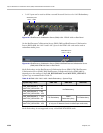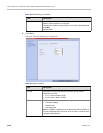
Polycom RealPresence Collaboration Server (RMX) 1500/2000/4000 Administrator’s Guide
16-40 Polycom, Inc.
ISDN/PSTN Network Services
To enable ISDN and PSTN participants to connect to the MCU, an ISDN/PSTN Network
Service must be defined. A maximum of two ISDN/PSTN Network Services, of the same
Span Type (E1 or T1) can be defined for the RMX. Each Network Service can attach spans
from either or both cards.
Most of the parameters of the first ISDN/PSTN Network Service are configured in the Fast
Configuration Wizard, which runs automatically if an RTM ISDN card is detected in the RMX
during first time power-up. For more information, see the RealPresence Collaboration Server
(RMX) 1500/2000/4000 Getting Started Guide, "First Entry Power-up and Configuration” on
page 2-25.
Supported Capabilities and Conferencing Features:
• ISDN video is supported only in Continuous Presence (CP) conferences.
• Only BONDING (using multiple channels as a single, large bandwidth channel) is
supported.
• Simple audio negotiation.
• Supported video resolutions are the same as for IP.
• Supported video Protocols are the same as for IP: H.261, H.263, H.264.
• H.239 for content sharing.
•Lecture Mode.
•DTMF codes.
• Securing of conferences.
• Basic cascading between two MCUs using an ISDN link is available and forwarding of
DTMF codes can be suppressed.
Non Supported Capabilities and Conferencing Features:
• NFAS (Non-Facility Associated Signaling)
• Leased line usage
• Restricted Channel mode
• Aggregation of channels
• V.35 serial standards
• Primary and secondary clock source configuration (they are automatically selected by
the system)
• Auto detection of Audio Only setting at endpoint
• Auto re-negotiation of bit rate
• Additional network services (two currently supported)
• Change of video mode (capabilities) from remote side during call
• Audio algorithms G.729 and G.723.1
•FECC
• H.243 Chair Control
• T.120 data sharing protocol
• H.261 Annex D
• MIH Cascading using an ISDN connection as cascade link


















